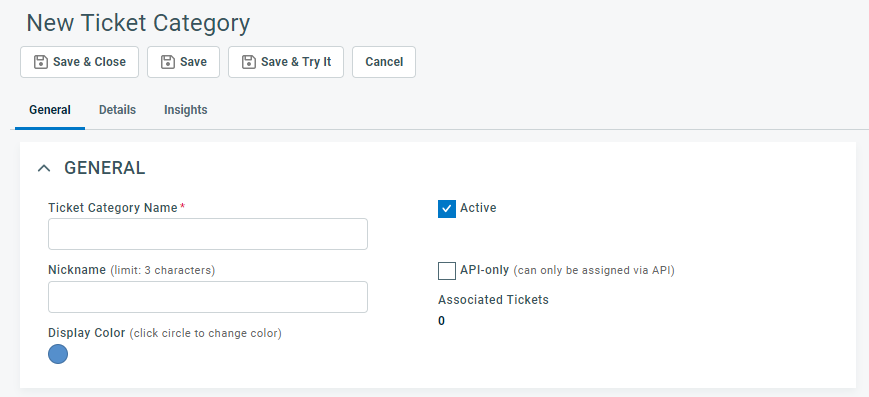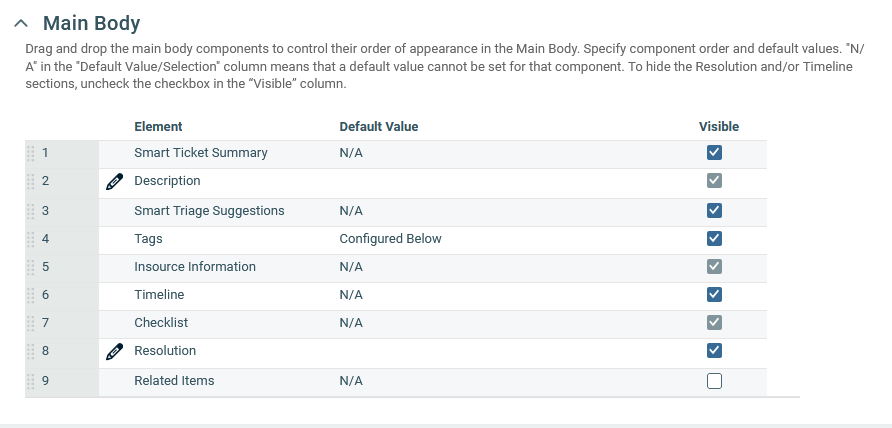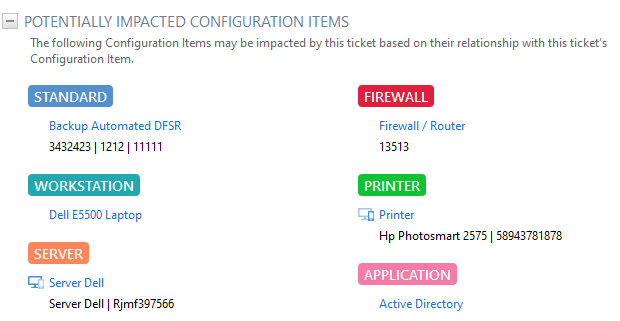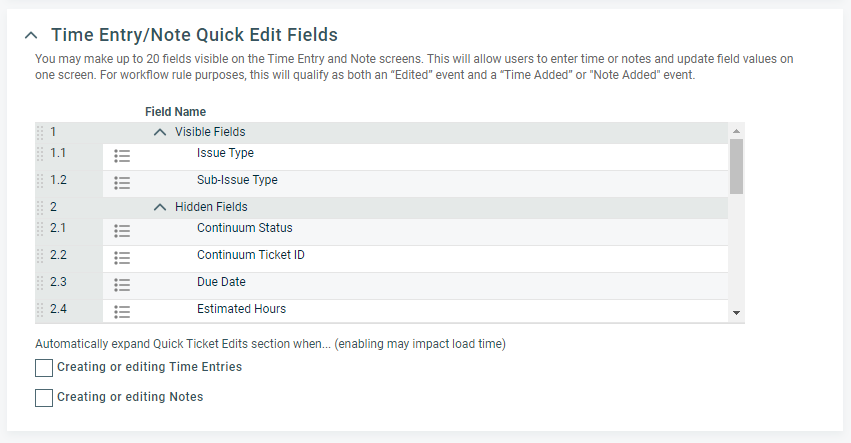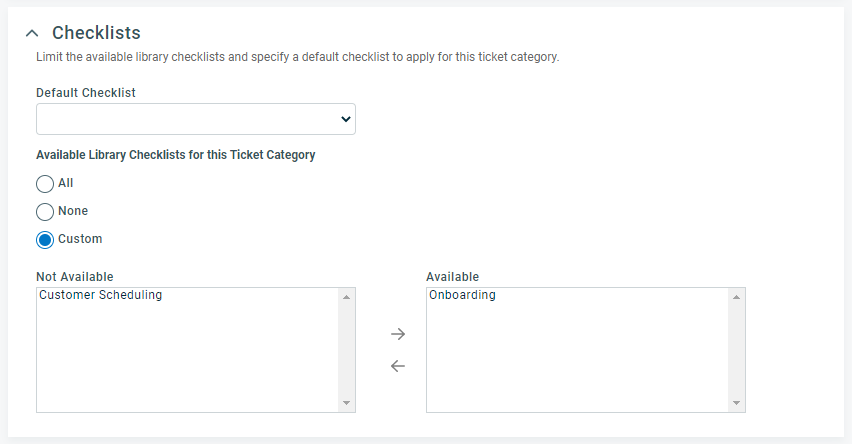The General tab
On the General tab, you select the fields that will be displayed, set the properties of the category, and configure the components of the main panel.
NOTE This topic describes the General tab of the New Category or Edit Category pages. The page has two additional tabs: Details tab and Insights tab. For details on these tabs, refer to The Details tab and The Insights tab.
Sections by entity category
The General tab of the New Category or Edit Category pages is broken into expandable sections that allow you to configure the components that will appear on the main panel of the entity. Not all sections are present on the category pages of all entities. Here is an overview by entity category:
| Section Name | Ticket | Task | Opportunity | Device | Organization |
|---|---|---|---|---|---|
| General | |||||
| Header | |||||
| Main body |
|
||||
| Change Info fields |
|
||||
| Change Approvals |
|
||||
| Checklists |
|
||||
| Available (Organization) Form Templates |
|
||||
| (Available) Notification Templates |
|
||||
| Tags |
|
||||
| Other options |
|
||||
| Other options during organization creation |
|
|
|
|
|
| Time Entry/Note Quick Edit Fields |
|
Detailed description of each section
In this section, you will name the category, select a color to associate with the category, specify whether the category is currently active, and more.
| Field | Description |
|---|---|
|
[Entity] Category Name
|
This field is always required. Enter or edit the Name. Each name must be unique, and can have no more than 30 characters. The category name appears on the item and in the field menus of entities where it is applied. TIP As best practice, the name should reflect how the category will be used in your company's workflow. |
|
Display Color
|
Select a Display Color for the category. The display color appears next to the category name on Categories lists, on the category badge Click the Display Color icon |
|
Active check box
|
Select the check box to activate the category, or clear the check box to inactivate the category.
The maximum number of active categories for the various entities are the following:
|
|
API-only (can only be assigned via API)
|
Available on the Ticket Categories and Device Categories pages only. Select the check box if you would like the category to be available only when creating or editing an item via the API, and not in the UI. Exceptions are when you copy an item created via the API or mark a ticket as an incident and associate it with a new problem. When you are editing a category, the API-only check box is disabled if:
Refer to API-only Categories. |
|
Associated [items]
|
Indicates how many individual items are associated with the category. You cannot delete a category that is associated with one or more items. This field is read-only. |
The Header section contains the list of fields that are displayed for every category for that entity. They appear at the top of the main panel when the category is applied. For some fields, you can configure a Default Value/Selection and limit any Available List Values.
The following table describes the header fields. To edit a row, select Edit from the row's context menu, or click on the row.
| Field name | Default Value / Selection | Available List Values |
|---|---|---|
|
[Entity] Category
|
When you add a new ticket, task, opportunity, or device, the default category is determined by one of the following settings:
When you edit an item, this field shows the category that is currently assigned. On the New [Entity] and Edit [Entity] pages, you can always select a different category. |
You can limit the categories available when adding or editing an item associated with this category. To specify which categories are available in the category menu, click the pencil icon. Move the items that you want to appear in the menu to the right side pane. Move any items you do not want in the menu to the left side. |
|
Ticket Type (tickets only) |
If you want to specify a default ticket type to populate the Ticket Type field on all tickets associated with this category, select it from the menu. Users will be able to change the Ticket Type when adding or editing the ticket. TIP If you want to set one ticket type as the only ticket type for tickets associated with this category, edit the available list values and set the default value as the only item in the menu. |
You can limit the items available for selection from the Ticket Type field menu when users add or edit a ticket associated with this category. Click the pencil icon to open the list item selector. Move the items that you want to appear in the menu to the right side panel. Move any items you do not want in the menu to the left. |
|
Title (tickets and tasks only) |
If you want all tasks or tickets associated with this category to have a default title, enter that title here. The Title field can be edited when adding or editing an item associated with this category. TIP You can enter a prefix that you would like to use for all tasks or tickets in this category and let users enter a descriptive title after the prefix. For example, you could set the default title to ALERT: and then have users add a specific title for the alert issue after the prefix. |
This is a text-entry field. There is no list to edit or configure. |
|
Name (opportunities only) |
Enter a default Name for all opportunities associated with this category. The Name field can be edited when adding or editing an opportunity associated with this category. TIP You can enter a prefix that you would like to use for all opportunities in this category and let resources enter a more descriptive name after the prefix. For example, you could set the default name to CONTINUITY UPGRADE - and then have users enter descriptive text after the prefix. |
This is a text-entry field. There is no list to edit or configure. |
|
Device Type (devices only) |
By default, this field is optional. Select a default Device Type for the category. |
To specify the device types that are available in the category menus, click the pencil icon. Move the items that you want to appear in the menu to the right side panel. Move any items you do not want in the menu to the left side. |
|
Product (devices only) |
Select a default Product for the device category, if desired. | To specify the products that are available in the category menu, click the pencil icon. Click Custom to launch a Select Products dialog box. You can filter by Name, Description, Manufacturer, Active/Inactive status, or Category. |
|
Organization Name (organizations only) |
This field is always displayed and must be populated manually. |
N/A |
|
Organization Type (organizations only) |
Select a default option from any of the system organization types, or leave blank. |
You can limit the items available for selection from the Organization Type field menu when users add or edit an organization associated with this category. |
The Main Body section lets you select the body components that will appear on items associated with the category.
NOTE Organization categories do not have this section.
The following components are available for the various entities. Items in bold are always visible.
| Ticket | Task | Opportunity | Device |
|---|---|---|---|
|
Smart Ticket Summary Description Timeline Smart Triage Suggestions Checklist Insource Information Resolution Tags Related Items |
Description Timeline Checklist |
Description Timeline Checklist |
Description Details from RMM (Devices only) Details from Datto BCDR (Devices only) SSL Source (SSL Certificates only) SSL Details (SSL Certificates only) Domain (Domains only) WHOIS Information (Domains only) DNS Record (Domains only) Related Items |
Change the display order
The left column in the table displays a number for each row. That number indicates the order in which the components appear on items associated with this category.
To change the display order of the components, drag and drop a row to a new location on the table.
![]()
TIP The thick blue line that appears in the table shows where the new row will be dropped.
Configure the Main Body components
| Element | Default Value | Visible or not |
|---|---|---|
|
(all entities) |
Enter a default Description for items created with this category. No more than 8,000 characters may be entered.
|
Selected and disabled. The Description field is always visible. |
|
Timeline (tickets, tasks, and opportunities) |
The Timeline is an optional visual element that does not use a default value. The category controls whether it appears on associated items. When visible, the timeline draws its start and complete dates from
|
When the check box is selected, the timeline is visible. Click the check box to clear or select it. |
|
Checklist (tickets, tasks, and opportunities) |
The Checklist component cannot be removed, although it is not always visible. The content of the checklist is configured on the New [Entity] page or Edit [Entity] page. If the checklist is empty, it will be hidden. Refer to The checklist. |
Selected and disabled. If the checklist is empty, it will be hidden. |
|
Insource Information (tickets) |
This component is not configurable. Insource information comes directly from the insourced ticket, so the field does not support a default value. The field is not editable on the New Ticket page or the Edit Ticket page.
|
Selected and disabled. This element cannot be removed from the ticket category, but it will appear on the ticket only when the ticket has been created from an insourced ticket. |
|
Smart Ticket Summary
(tickets) |
This component is an optional element that does not use a default value.
When visible, you have the option to generate a ticket summary based on the ticket details. Refer to Smart Ticket Summary. |
Visible when selected. |
|
Smart Triage Suggestions
(tickets) |
This component is an optional element that does not use a default value.
When visible, you have the option to generate a ticket triage analysis summary based on the ticket details. Refer to Smart Ticket Triage. |
Visible when selected. |
|
(tickets) |
You can set a default value to populate the Resolution field on all new tickets associated with this ticket category. For details on the dialog box, refer to Description. |
You can hide the resolution component. The Visible check box is editable. You do not need to click the pencil icon. When the check box is selected, the Resolution field appears on the ticket. Click the check box to clear or select it. |
|
(tickets)
|
The Tags component is optional. When it is selected, you are able to set default tags that will be applied, and whether tags are organized by tag group.
You can associate up to 30 tags with a ticket.
|
Clear the check box to hide the tags section or ensure it's selected if you'd like to set default tags for tickets within this category. |
|
Related Items/ Potentially Impacted Devices (tickets and devices) |
This component displays devices that are related to the device, or the primary device associated with the ticket. When it is made visible for the ticket category, the primary device associated with the ticket is listed first, including Product Name, Reference Name, Reference Number, and Serial Number, if available. Any parent or child devices of the primary device are listed below, grouped by device category. If the primary has a parent device, the product name of the parent is listed above the product name of the primary. On Ticket pages, this section is called Potentially Impacted Devices, and devices that are related to the ticket's device appear there. Refer to Managing relationships between devices (The Related Items tab). |
Visible when selected. |
|
Details from RMM (devices) |
This component appears on all device categories except for Domain and SSL Certificate, even if the Datto RMM integration is not enabled.
|
Always visible |
|
Details from Datto BCDR (devices) |
This component appears on all device categories except for Domain and SSL Certificate, even if the Datto RMM integration is not enabled. | Always visible |
|
SSL Source (SSL Certificates only) |
This component appears only on devices where the SSL Certificate category was selected. It allows you to enter either the domain host or the PEM-encoded SSL Certificate. | Always visible |
|
SSL Details (SSL Certificates only) |
This component appears only on devices where the SSL Certificate category was selected. It contains a number of read-only fields sourced from the SSL Certificate/Host. The following fields are displayed:
|
Always visible |
|
Domain (Domains only) |
This component appears only on devices where the Domain category was selected. It allows you to enter either the domain name. | Always visible |
|
WHOIS Information (Domains only) |
This component appears only on devices where the Domain category was selected. It contains the following read-only fields:
|
Always visible |
|
DNS Record (Domains only) |
This component appears only on devices where the Domain category was selected. It contains a searchable table of DNS records. | Always visible |
Tickets only.
The Change Info area is collapsed by default. The table in this area displays the five Change Info fields available only on Change Request tickets. The change info fields appear on the Change Info accessory tab, found only on Change Request tickets. Change Info fields are all direct text entry. For more on Change Request tickets, refer to Change management.
In this table, you can specify which Change Info fields will be displayed on tickets associated with this category, the order in which they appear, and whether or not a field is required. You can also specify default values for the fields.
Configuration options for the Change Info fields table are described in the following table.
NOTE Your organization can customize the names of the change info fields. Refer to Managing change info fields.
| Column | Description |
|---|---|
| Order Top to Bottom |
For each row, this column displays a number that indicates whether or not the field in that row appears on change request tickets associated with the category:
To change the display order of the fields that display on tickets (the fields listed under row 1, Visible Change Fields), click and drag and drop the rows to arrange them in the preferred display order. |
| Context Menu |
Each field's row has a context menu with two options, Edit and Remove.
|
| Field Name | Displays the name of the Change Info field. The name cannot be edited here because Change Info Field names are not specific to tickets or ticket categories. They are set at the Admin level. Refer to Managing change info fields. |
| Default Value |
The default value specified in this column is applied to this row's Change Info field on the Change Info tab of new change request tickets that are associated with this ticket category. The field can be edited at the ticket level.
|
| Required | When this check box is selected, the field in this row will be required on change request tickets associated with this ticket category. Users will not be able to save the ticket if a required field is empty. |
Tickets only.
The Change Approvals section helps you manage the settings that are critical to ensuring effective change management in your business processes. See Change management for more information.
| Field | Description |
|---|---|
| Change Advisory Board | Select a default change advisory board to review tickets created under this ticket category. See Managing change advisory boards for information on creating change advisory boards. Active boards will appear on this list. |
| Other Resource Approvers | Select any other resources you would like to approve tickets created under this ticket category. |
| Approval Type |
Select an approval type, either:
|
| Automatically request approval | Select the check box to automatically send approval requests. Reviewers view change requests on the My > Service Desk > Workspace & Queues > My Change Approvals tab. |
In this section, use the Available Library Checklists selector to specify which checklists, if any, from the Checklist Library will be available to add to tickets, tasks, or opportunities associated with this category. The category controls which library checklists, if any, are available for selection in the Checklist menu when you add or edit the item, and the default checklist. You can limit the menu selections to checklists that are suitable for items associated with this category. This becomes increasingly helpful as your checklist library grows.
TIP If you prefer one particular checklist for items associated with this category, make that checklist the only one available for selection. But be aware that the user does not have to select a checklist from the library. A checklist can be created directly on the ticket.
For more on checklists, refer to The checklist.
For details on using the Available Library Checklist selector, refer to Using the Available List Values selector.
Opportunity, Ticket, and Task categories allow you to select which Organization Form Templates will be available when the category is applied. Ticket and task categories additionally let you select which Ticket and Task Time Entry and Note Form Templates will be available. Only form templates published to the entire organization can be selected.
In this way, you can limit the form template menu selections to templates that are suited for the items the category is designed for. This can be a real time saver if your local organization has a large number of form templates.
NOTE On entity pages, users are able to select not only from the form templates permitted by the category but also from their personal form templates and any form templates created for departments they are associated with. Categories cannot hide those form templates.
For more on form templates, refer to Form templates and ticket categories, task categories, and opportunity categories.
For details on using the Available Organization Form Templates selector, refer to Using the Available List Values selector.
(Available) Notification Templates for this [Entity] Category
All entity categories except the oeganization categories allow you to select which notification templates will be available when the category is applied. In this way, administrators can ensure that users send out the right communications when notification emails are sent out manually.
The available notification options are also impacted by the events that trigger the notification. Refer to Events that can trigger notifications.
By default, All (notification templates) is selected. To limit the selection, click Custom, and use the list values selector to move notification templates from the Available to the Not Available pane. Refer to Using the Available List Values selector.
Notification Templates for Quick Notes and Quick Time Entries
Tickets only.
For ticket quick notes and quick time entries, you can select a separate notification template.
- If you select Use System Default, the system default template for ticket notes or ticket time entries will be used.
- If you select Custom, the Notification Template used for Quick Notes or Notification Template used for Quick Time Entriesfield is enabled. Click the field and make a selection. All ticket note and ticket time entry templates are available.
EXAMPLE This allows you to specify a separate notification template for co-managing users versus internal resources.
Special circumstances
Please note the behavior under the following circumstances:
- Workflow rules: When you are creating a workflow rule, all notification templates are available, regardless of the ticket category.
- No notification template available for an event: If no notification template is available for an event for a category, the default template for the event is used, even if it is not selected on the category.
- Form template contains an unavailable notification template: If a form template is selected that contains an unavailable notification template, the previously selected notification template will be used.
- Render all Tickets as Ticket Category: The available notification templates will be those of the category the ticket is rendered as.
- Co-managed security levels: The available notification templates will be those made available in the Notification Template for Quick Notes section.
Tickets only.
Tags are optional. If you made the Tags component of the main body visible, you may want to choose specific tags to automatically assign to tickets when they are created with this ticket category.
- In the Add a tag... field, start typing the name of a tag, or click the selector icon and select one or more tags.
- To group multiple tags first by tag group and then alphabetically by tag, click Organize by Group.
NOTE Tags will not be applied to categories where the Tag section is hidden.
This option can override or respect the corresponding Timesheet system setting (Round service desk time entries up to the nearest # minutes), for all time entered on tickets associated with this ticket category.
NOTE When enabled, the corresponding system setting rounds time entries up to the nearest number of minutes, based on the number of minutes specified for the system setting. For example, if the system setting specifies 15 minutes, a time entry with a stop time of 9:50 AM will be rounded to 10:00 AM on the timesheet and for billing purposes (or for billing purposes only if a different system setting Do not round hours worked for task or ticket time entry is also enabled). Refer to Timesheets system settings.
Select one of the following menu items:
| Selection | Description |
|---|---|
| Use system setting: Round to the nearest # minutes | This choice respects the Timesheet system setting. In Autotask, the # is replaced with the number of minutes specified in your system setting. If time entries are not being rounded, the # is replaced with 0. If you want this ticket category to override the system setting, select one of the other choices. |
| Round ticket time entries to the nearest # minutes | Overrides the system setting and instead rounds time entries for tickets associated with this ticket category based on the number of minutes you specify here. When selected, the # Minutes field to the right of the menu becomes active. Enter the number of minutes you prefer for this ticket category. |
| Do not round | If the current system setting is rounding time entries, this selection will override the system setting, and time entries will not be rounded. |
NOTE Selections made here do not impact whether or not the timesheet system setting Do not round hours worked for task or ticket time entry is enabled. Refer to Timesheets system settings.
Tickets only.
This setting determines whether the Queue field is required on tickets associated with the ticket category. The Queue field is selected for display on the ticket Details tab (refer to The Details tab).
The Queue is Required setting replaces the Required check box for the Queue field on the Details tab of the New Ticket Category and Edit Ticket Category pages. Many Service Desk workflows require a ticket to be assigned to either a Queue or a Primary Resource, but not necessarily both. The Required check box cannot support this either/or choice. The Queue is Required setting provides the option to require the Queue field only when no Primary Resource is specified.
Select the setting you want for tickets associated with this category:
| Setting | Impact on tickets associated with the ticket category |
|---|---|
| Always | The Queue field is always required. This selection requires that the Queue field is visible (not hidden) on the Details panel or has a default value specified, or you cannot save the ticket category. |
| When Primary Resource is Blank | This is the default setting for the New Ticket Category page. The Queue field is required when no value is provided for the Primary Resource field. This selection requires that both the Queue and Primary Resource are visible on the ticket Detail panel (neither are hidden), or you cannot save the ticket category. |
| Never | The Queue field is never required. With this setting, tickets can be created or edited without either a queue or resource assigned. |
Tickets only.
- If Enable Complete button on Ticket Detail is selected (default), users can complete the ticket by simply clicking the button.
- If cleared, the button is hidden.
Tickets only.
- If Allow Quick Time Entry is selected (default), a Minutes box is displayed next to the quick note field on the ticket's Activity tab. You will be able to create a time entry by entering the number of minutes, or selecting a time increment from the overlay.
- If cleared, this option is hidden on the ticket page.
Tickets only.
- If Allow users to modify Role when creating/editing time entries on tickets is selected, users can select any role they are associated with in any department or queue when they are entering or editing time on a ticket.
- If cleared, users can only enter or edit time using the assigned role.
- If Enable Ticket Stopwatch is selected, the stopwatch tracks the amount of time you spend working on a task or ticket. It automatically starts, stops, and pauses on various ticket- and task-related pages, so that you can be sure of consistent and accurate time-keeping among your resources.
- If cleared, the stopwatch is hidden.
Tickets only.
- If Allow users to add charges while creating/editing time entries on tickets is selected, the Add Charge section on the New and Edit Ticket Time Entry dialog boxes will appear when users create or edit a time entry for a ticket with this category.
- If the check box is cleared, the section will not appear.
Tickets only.
- If Require user to change ticket status from New when entering time (applies only to user interface) is selected, users must change the ticket status from New when entering time.
- If the check box is cleared, users do not have to change the status on a ticket if the status is New when they enter time on the ticket.
NOTE You cannot edit the Status field on a time entry if you open the Time Entry page from the Ticket page when the ticket page is in edit mode. If this system setting is enabled, you will not be able to save the time entry until you save the ticket.
Tickets only.
- If Require user to enter a reason for completion and reason for re-opening when completing / re-opening a ticket is selected, users must enter a reason, in the form of a note, for completing or reopening a ticket by updating the status in the Edit Ticket page. When the ticket is completed from the time entry page or the ticket note page, a note is always required.
- If the check box is cleared, users can complete and re-open tickets without providing a reason.
NOTE When a ticket is completed as part of a ticket merge, the note that is automatically created for the merge will fill this requirement.
Tasks only.
If Require user to enter a reason for completion when completing a task is selected, users must provide a reason when they set a task status to Complete, and this category is assigned to the task. A dialog box will open for the user to type the reason.
If the check box is cleared, users can complete tasks associated with this category without providing a reason.
Tasks and Tickets only.
If Require titles on task | ticket notes is selected, users must enter a note title. This is the default.
If the check box is cleared, the title field is available on task or ticket notes, but it is not required. If the title is blank, the Title field is hidden.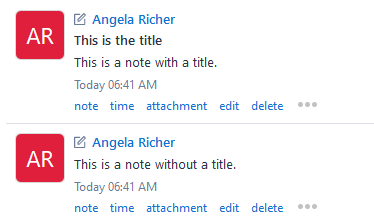
This setting does apply to the quick note and quick reply features, as well. If titles are optional, quick notes and quick replies will not use the first 250 characters of the description as the note title.
Tickets only.
If Enable Impact and Urgency fields to help determine ticket Priority is selected, users can populate these fields during ticket creation to help them with setting the appropriate ticket priority. Refer to Mapping Impact and Urgency.
If the check box is cleared, the ticket priority must be set manually. This is the default.
(Organization only)
When you create a new organization, you can, at the same time and on the same form, create a contact, note, and to-do. The visibility of fields from these entities is controlled by the organization category. All options are visible by default.
-
To hide the components from the main body, clear the option.
-
To change the order of appearance, drag and drop an element to a new location on the table.
Tickets only.
This setting allows you to select up to twenty additional ticket fields to appear on the New Time Entry, Edit Time Entry, New Note, and Edit Note pages under the Quick Ticket Edits heading. Making a field visible allows it to be modified when you enter time or add a note on the ticket.
- To show or hide a field, select Make Field Visible or Remove Field from the context menu
 . Alternatively, drag and drop the field's row to and from the Visible Fields and Hidden Fields sections by clicking in the Order column on the left.
. Alternatively, drag and drop the field's row to and from the Visible Fields and Hidden Fields sections by clicking in the Order column on the left. - To change the display order of the fields, click in the Order column on the left and drag and drop the rows into the preferred display order.
Fields in the Quick Ticket Edit section are not visible when the section is not expanded. Required fields must be visible to be validated when the time entry or note is saved. If the Quick Ticket Edit section includes any required fields, it must be expanded to allow Autotask to confirm that the required fields contain values when the time entry or note is saved.
Select one or both of the Creating or editing Time Entries and Creating and editing Notes options to automatically expand the Quick Ticket Edit section when a time entry or note is opened for creating or editing. This will ensure that your resources have entered values into those required fields when the time entry or note is saved.
Depending on the number and type of fields in the Quick Ticket Edits section, selecting these options may increase the amount of time it takes for the time entry or note form to open.
Several sections on the General and Details tabs use available list value selectors to determine what options appear in menus or data selectors. By default, all list values will be available in menus and data selectors.
To limit the available options, click the Custom radio button. The Not Available List Values and Available List Values for this Ticket Category panes become active.
To move items:
- Double-click a single item to move from one pane to the other.
- Ctrl + click multiple items in one pane and then click the appropriate directional arrow to move the items to the other pane.
TIP Double-check to be sure that all items you want to show are in the right pane and all items you want to hide are in the left pane.
